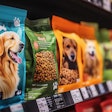
Sponsored content by Tree Top Ingredients
Companion animals form an integral part of family life and have much more in common with their pet parents than shared social activities and mutual affection. As they get older, pets can experience some of the same types of age-related health problems as humans. And these health issues can be related to oxidative stress.
Oxidative stress is triggered when the animal’s body doesn’t have enough antioxidants to neutralize free radicals. This excess of free radicals can lead to cell and/or tissue damage and is related to chronic conditions such as cancer, diabetes and heart disease to name a few.
The body produces free radicals during its normal metabolic processes. However, several factors can exacerbate oxidative stress by stimulating excess production of free radicals. These factors can include diet, lifestyle, physical injury or environmental conditions like pollution, noise and crowds.
Urban Woes
Pollution, noise and crowds are found to a greater degree in urban areas than rural, pointing to one primary stressor, which is the environment. Evidence suggests that urban pets (and people) are exposed to conditions more likely to cause oxidative stress than those that inhabit rural areas.
One study 1 links five urban factors with triggering an inflammatory response and subsequent oxidative stress. These include: chemical, noise and light pollution; infectious disease; and diet quality.
A recent study examined oxidative stress levels in the house sparrow. The house sparrow was selected because it is a globally distributed species and is well adapted to urban life.
Despite this adaptation however, when blood samples were drawn and compared among birds that inhabit three different environments common to the house sparrow—urban, suburban and rural—the urban sparrows displayed higher levels of oxidative damage and lower antioxidant capacity compared to rural birds. This finding demonstrates some of the urban stressors common to not only birds but other living creatures, such as pets 2.
Simple Aging

Antioxidants: The First Line of Defense
Clearly part of the solution for combatting oxidative stress is to find its antidote. In the case of oxidation, it is the antioxidant, sourced from certain fruits and vegetables, that can be added to the diet and help neutralize free radicals.
Antioxidants supply multiple health benefits, including but not limited to anti-inflammatory effects, positive impact on immunity, retinal responses and physiological changes in the brain.
Immunity
Inflammation or an inflammatory response is the first line of defense to combat harmful stimulus. The types of stimulation that can trigger an inflammatory response can range from physical wounds like cuts and bruises to infections, exposure to pollution or even noise. When the inflammatory response is triggered, this enhances the production of free radicals which in turn causes oxidative stress, particularly when it happens on a repeated basis. Persistent or chronic inflammation has been linked to multiple major diseases, such as arthritis, cancer, heart disease and Alzheimer’s to name a few.
Anti-inflammatory Foods
Many fruits and vegetables contain a diverse array of phytochemicals known as phenolics. This includes flavonoids, such as anthocyanins. Some anthocyanins, like quercetin for example, can cross the blood-brain barrier. Phytochemicals have a complex molecular structure allowing them to bind free radicals, so they can not attack metabolic systems within the body.
Some of the fruits experts recommend for their anti-inflammatory properties can include pineapples, apples, mangos, cantaloupes and berries, particularly blueberries. Vegetables like pumpkin, squash, sweet potatoes and carrots can also be very helpful for inflammation due to the beta-carotene content.
Visual Response
Antioxidants are now documented as influencing retinal response, particularly in dogs. A specific study published in the Journal of Nutritional Science 4 found, “Antioxidant supplementation…may be beneficial and effective in the long-term preservation and improvement of various functions of the canine eye.” The study looked at beagles given a feeding regimen with or without antioxidant supplementation. Compared with the control group, the antioxidant-supplemented group showed improvement to varying degrees for retinal function and “significantly less decline in refractive error.” Dogs do experience vision decline as they age. Retinal degeneration and a cloudy lens are “common forms of eye problems that results in a decline of visual function in dogs.”

Heart Disease
Heart disease is another health issue related to oxidative stress. A study published in Veterinary Medicine International 5 said that heart failure was one of the main causes of death for domestic carnivores. Well adapted nutrition it said, “constitutes a major asset to improve the well-being and life expectancy” of these companion animals. A study found that in dogs with heart failure, their cellular metabolism isn’t working properly, leading to production of a large number of free radicals. However, a proper diet supplemented with the right blend of vitamins and polyphenols can increase the concentration of antioxidants to help neutralize free radicals and improve the canine’s cellular metabolism.
Anthocyanin: A Powerful Polyphenol
Among antioxidants, one particular group of compounds called anthocyanins has excited the medical and scientific community as specific benefits associated with them are identified and studied. Anthocyanins are found abundantly in brightly colored fruits and vegetables and responsible for bright red-orange and blue-violet pigmentation. The concentration of anthocyanin within any given food type will vary. Links have been found between anthocyanins and cardiovascular disease, cancer and cognitive function.
Flavonoids like anthocyanins can aid with memory and help stem the tide of age-related cognitive decline. Several factors are at work here, including their ability to inhibit neuroinflammation and improving blood flow to the brain. One more important factor is that certain anthocyanins can cross the blood brain barrier, making them more effective in a direct fashion in terms of beneficial cognitive effects.
One animal study of aged rats, which were fed blueberries,6 revealed a relationship between cognitive performance tested in a maze, and the total number of anthocyanin compounds found in the cortex. The anthocyanins or polyphenolic compounds in the blueberries were able to cross the blood brain barrier and localize in various brain regions important for learning and memory.
A series of studies looked at the memory response or brain aging in older dogs and found that an antioxidant-enriched diet enabled the dogs to learn complex tasks with greater success than the dogs fed a control diet without antioxidants.7 And yet another study found that older dogs fed an antioxidant-enriched diet displayed cognitive improvement within two weeks of starting the enriched diet, and when combined with mental stimulation, the effects were “even greater.”
Dogs fed a diet high in antioxidants in another study, could recognize family members and other animals more easily than the control group. In addition, the dogs displayed a greater degree of agility with the anti-inflammatory effects of antioxidants in play.
Antioxidants even have been shown to help dogs and cats that suffer from allergy or coat and skin problems. Experts recommend that owners may want to start antioxidant supplementation while dogs are still young, rather than waiting until they’re older, to lower the chance of the dog developing cognitive dysfunction syndrome (CDS) later in life.8
Antioxidant Sources
Clearly, the addition of antioxidant-containing ingredients to kibble or in pet treats can be an effective means of supplementing the companion animal diet to effectively counter oxidative stress.
Fruit in pet treats, for example, can add fiber, aid with texture and humectancy, enhance color and flavor, and of course, supply antioxidant components that can combat health concerns related to oxidative stress. Adding to this list of benefits, fruit and vegetable ingredients contain no fat and are typically lower in calories than many other ingredients.
It is possible to add a greater percentage of fruit to a mix-in or a treat to maximize the potential phytonutrient content than if it were added within the formulation of standard kibble. Different formulations can tailor the fruit content and type to design treats or mix-ins that target different animal demographics, such as senior pets.
A listing of some of the potential fruits and vegetables suitable for canine consumption are listed in the sidebar. The various phytonutrient benefits associated with the individual fruits and vegetables are also listed, although a more thorough explanation is available through personal consultation with one of Tree Top Fruit Ingredients Specialists.
Mix-ins or Treats
One option for adding functional benefits to a pet’s diet is with a superfood mix-in or topper made with simple and easily recognizable ingredients, such as fruits mixed with vegetables and/or whole grains. Mix- ins supply consumers with an easy method of adding to standard kibble, a scientifically balanced blend of simple, wholesome ingredients to help impact weight management or improve certain health aspects.
Typically, these mix-ins or toppers contain antioxidant-rich ingredients that support overall health and well-being, while the free-from formulations appeal to picky pet parents. These toppers can be formulated free from soy, flavor enhancers, added sugar, artificial colors, and preservatives, and are both gluten- and GMO-free.
The second method of adding antioxidant-rich ingredients to a pet’s diet is via a chew or treat. A chew can also combine more than a single fruit ingredient and be designed for a specific health issue. For example, a combination of berries with a high anthocyanin content could be designed for the urban dog to combat the daily stressors that can cause an oxidative/free radical imbalance. In one sample, human grade ingredients blend beef broth, with a variety of fruits selected for their phytonutrient content, mixed with peanut butter, some puffed cereal of brown rice and select spices.
Leveraging the antioxidant properties of fruit and vegetable ingredients for companion animal formulations can help improve quality of life, help combat diseases, and help mitigate the memory loss for a happier, healthier canine. These naturally tasty ingredients offer functional benefits, clean label attributes and an impressive portfolio of phytonutrients that will please pet parents as they see improvements in their dog’s health and well-being.
For more information about Tree Top Ingredients pet food solutions visit https://foodingredients.treetop.com/fruit-ingredients-blog/Category/Pet-Scoop-Blog/.
References
- Isaksson, C. (2015), “Urbanization, oxidative stress and inflammation: a question of evolving, acclimatizing or coping with urban environmental stress.” Funct Ecol, 29: 913-923. doi:10.1111/1365-2435.12477
- Herrera-Dueñas Amparo, Pineda-Pampliega Javier, Antonio- García María T., Aguirre José I. (2017), “The Influence of Urban Environments on Oxidative Stress Balance: A Case Study on the House Sparrow in the Iberian Peninsula.” Front Ecol Evol, 5. doi.org/10.3389/fevo.2017.00106
- Alexander, J. E., Colyer, A., Haydock, R. M., Hayek, M. G., & Park, J. (2017). “Understanding how dogs age: Longitudinal analysis of markers of inflammation, immune function, and oxidative stress.” The Journals of Gerontology: Series A Biological Sciences, 73 (6): 720-728 https://doi.org/10.1093/gerona/glx182
- Wang, Wei et al. (2016) “Antioxidant supplementation increases retinal responses and decreases refractive error changes in dogs.” Journal of Nutritional Science vol. 5 e18. 10, doi:10.1017/jns.2016.5
- Sagols, Emmanuelle, and Nathalie Priymenko. (2011) “Oxidative stress in dog with heart failure: the role of dietary fatty acids and antioxidants.” Veterinary Medicine International vol. 2011 180206. doi:10.4061/2011/180206
- Andres-Lacueva, Cristina et al. (2005) “Anthocyanins in aged blueberry-fed rats are found centrally and may enhance memory.” Nutritional Neuroscience 8(2):111-120, doi.org/10.1080/10284150500078117
- Dowling, Amy L S, and Elizabeth Head. (2012) “Antioxidants in the canine model of human aging.” Biochimica et biophysica acta vol. 1822,5: 685-9. doi:10.1016/j.bbadis.2011.09.020
- Cotman CW, Head E, Muggenburg BA, et al. (2002) “Brain aging in the canine: a diet enriched in antioxidants reduces cognitive dysfunction.” Neurobiol Aging 2002;23:809–818.
- Arulselvan, Palanisamy et al. (2016) “Role of Antioxidants and Natural Products in Inflammation.” Oxidative Medicine and Cellular Longevity, doi:10.1155/2016/5276130
















